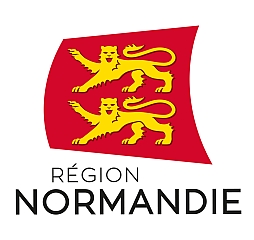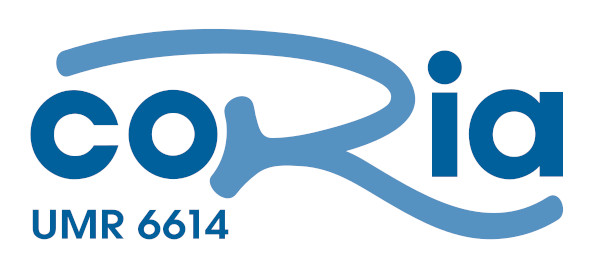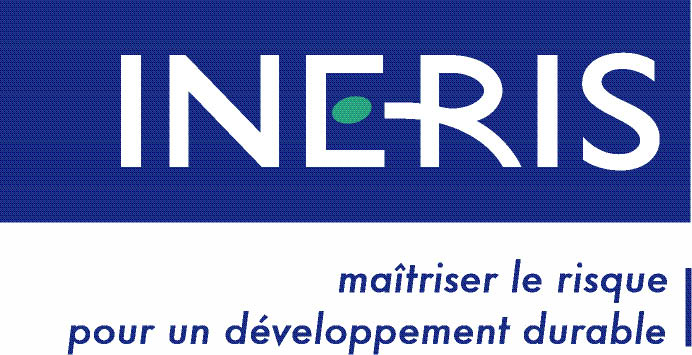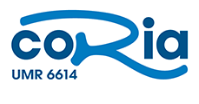Context
The methods available for tackling this problem can be divided into two broad categories. Firstly, so-called “low-fidelity" models [2], which are widely used in the risk management community, provide rapid results but are not capable of explicitly taking into account the influence of buildings and topography on the flow and are therefore irrelevant in areas with relief or built-up areas. On the other hand, ‘high-fidelity’ methods using CFD are capable of providing relevant information on flows in such areas, but are more complex to use and more expensive. In recent years, advances in numerical methods and the increase in computing power available have helped to make approaches of this type more affordable when applied to academic or even real-life configurations. Nevertheless, these tools are often limited to the average resolution of the flow (the so-called RANS approach) and suffer from validation limited to simplified configurations that are not very representative of realistic urban configurations. It is therefore necessary to propose high-performance, validated, high-fidelity tools capable of enhancing our knowledge of the physical phenomena driving pollutant dispersion. The ultimate aim is to be able to predict the concentration of chemical species at risk in a realistic
environment at an acceptable cost.
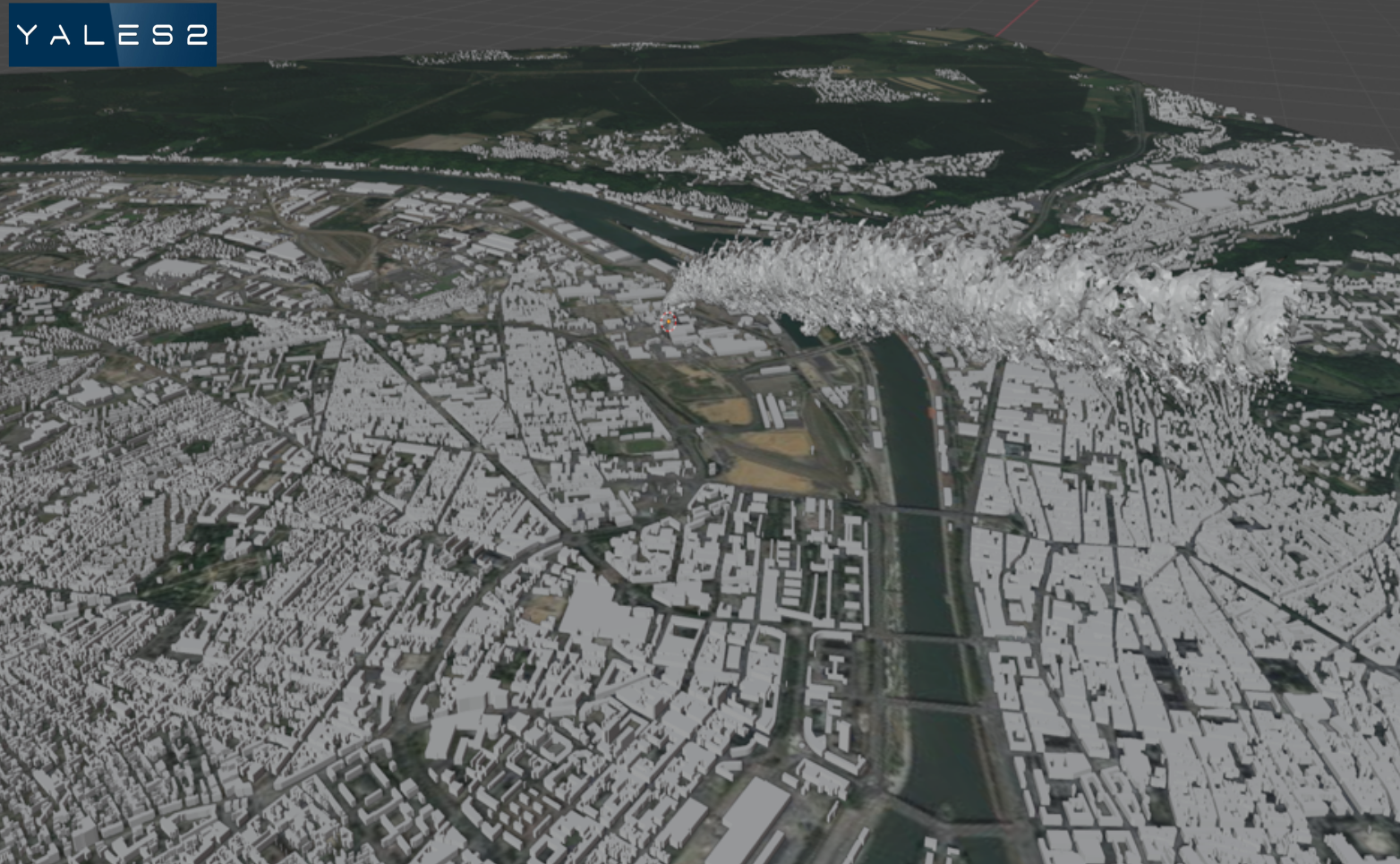
High-fidelity simulation of the Lubrizol Normandie Logistique fire using the YALES2 platform
PhD objectives
The aim of this thesis is to improve our knowledge of the dispersion of pollutants in built-up areas and with relief, and to enhance the tools used for prediction using high-fidelity numerical simulation. At the end of this work, a high-fidelity methodology that can be used in quantitative prediction studies of the concentration of hazardous species in real-life situations will be proposed.
The thesis will seek to provide answers to the following questions:
- How can a realistic atmospheric flow be generated and maintained in a neutral atmosphere with thermal stratification?
- What is the influence of temporal variation in the injected wind profile on the pollutant concentration?
- How can we best represent the pollutant source in order to predict the final mapping of the pollutant concentration?
- How can the return time of simulations be improved (using dynamic mesh adaptation, for example)?
Conducting a high-fidelity study of the dispersion of pollutants from an industrial accident involves modelling various physical phenomena. Among these, two phenomena will be given priority in this project: atmospheric flows and the pollutant source. These phenomena are crucial to the accurate prediction of the dispersion of pollutants [3,4].
To achieve these objectives, the thesis will be based on large-scale simulations (LES) carried out using the YALES2 CFD platform. YALES2 is a massively parallel, multiphysics, multi-scale numerical fluid mechanics code. As YALES2 has already been used for studies on the wake of wind turbines on farms, the atmospheric boundary layer models can be used and extended for the purposes of this thesis.
In practice, the work will be organized around the following points:
- Literature review and state of the art.
- Study of atmospheric flows with topography and buildings. Verification of the conservation of atmospheric flow characteristics.
- Development of an injection model for source pollutants. Validation by comparison with experiments. [5]
- Improved computational efficiency.
- Application of the complete methodology to a real case.
- Dissemination and exploitation of results: national and international conferences, publications.
Work environment
The proposed thesis is a continuation of the collaboration between the CORIA supervisory team and INERIS (Institut National de l’Environnement Industriel et des Risques), which was initiated as part of the COPHERL project following the Lubrizol-Normandie Logistique fire [6] and has continued ever since.
INERIS is the government’s expert on industrial risk management. It carries out research and expert appraisal work on technological risks in order to gain a better understanding of the phenomena likely to lead to situations involving damage to the environment, health and property. INERIS has extensive experience in the atmospheric dispersion of pollutants, as well as numerous experimental facilities, the results of which will be used in this thesis [7].
The CORIA management team has expertise both in risk management [6,8] and in high-fidelity numerical simulation of atmospheric flows [9,10]. Its members are the main developers of the YALES2 platform and will provide training and assistance to the candidate in the use of numerical tools.The thesis will take place mainly at the CORIA laboratory, but several long immersion stays at INERIS are planned during the thesis. The aim here is to benefit from the experience of each partner and to receive the best possible support in mastering the tools (calculation and post-processing code)
and experimental and numerical data.
General information
- 3-year PhD thesis, at the CORIA laboratory, Rouen, France and at INERIS, Verneuil en Halatte, France
- Salary: approx. €1,700 net/month
- Contract start date: preferably 1st October 2024
- Funding: 50% Normandy Region, 50% INERIS
- Contact: Léa VOIVENEL (lea.voivenel@coria.fr), Pierre BENARD (pierre.benard@coria.fr), Lauris JOUBERT (lauris.joubert@ineris.fr)
Applicant Profile
- Master’s level degree (Master’s or Engineer) in Mechanics or Energy (Fluid Mechanics, Aerodynamics, Scientific Calculation, CFD)
- Good oral and written communication skills (French or English required) to present at conferences and write scientific publications
- Application procedure:
- Send CV, covering letter and marks from Master 1 and 2 or equivalent engineering level to pierre.benard@coria.fr
- Application to be sent before 1st July 2024
- Incomplete applications will not be considered.
Références
[1] Tominaga, Y., & Stathopoulos, T. (2016). Ten questions concerning modeling of near-field pollutant dispersion in the built environment. Building and Environment, 105, 390–402.
[2] Stockie, J. M. (2011). The mathematics of atmospheric dispersion modeling. SIAM Review, 53(2), 349–372.
[3] Tabor, G. R., & Baba-Ahmadi, M. H. (2010). Inlet conditions for large eddy simulation: A review. Computers and Fluids, 39(4), 553–567
[4] INERIS. (2015). Guide de Bonnes Pratiques pour la réalisation de modélisations 3D pour des scénarios de dispersion atmosphérique en situation accidentelle.
[5] Fox, S., Hanna, S., Mazzola, T., Spicer, T., Chang, J., & Gant, S. (2022). Overview of the Jack Rabbit II (JR II) field experiments and summary of the methods used in the dispersion model comparisons. Atmospheric Environment, 269
[6] Incendie des usines Lubrizol et Normandie Logistique : COnséquences Potentielles pour l ’ Homme et l ’ Environnement , perception et RésiLience (COP HERL). (2021).
[7] Joubert, L., Leroy, G., Claude, T., & Riahi, O. (2023). Experimental Campaign of Massive CO2 Atmospheric Releases in an Urban Area. Atmosphere, 14(9).
[8] Betting, B., Varea, E., Gobin, C., Godard, G., Lecordier, B., & Patte-Rouland, B. (2019). Experimental and numerical studies of smoke dynamics in a compartment fire. Fire Safety Journal, 108, 0–25.
[9] Benard, P., Viré, A., Moureau, V., Lartigue, G., Beaudet, L., Deglaire, P., & Bricteux, L. (2018). Large-Eddy Simulation of wind turbines wakes including geometrical effects. Computers and Fluids, 173, 133–139.
[10] Vigny, Ulysse; Voivenel, Lea; Zeoli, Stephanie, Benard, P. (2022). Convective atmospheric boundary layer using LES. 18 Th EAWE PhD Seminar, November, 78.
